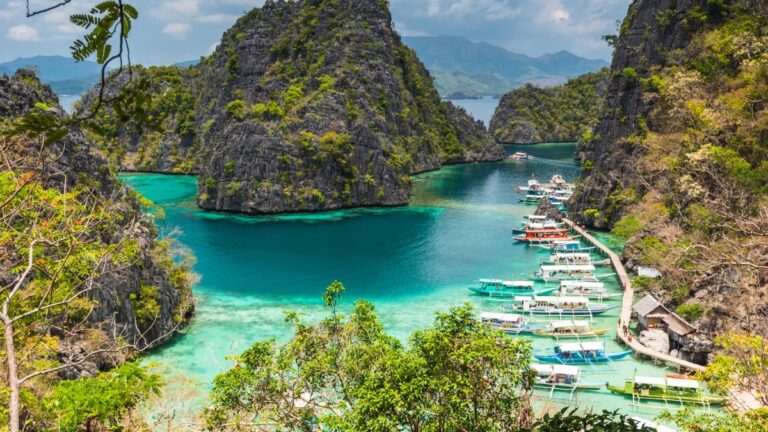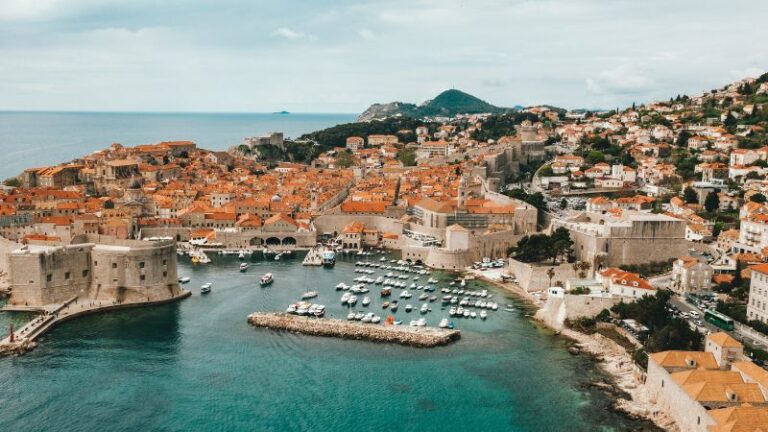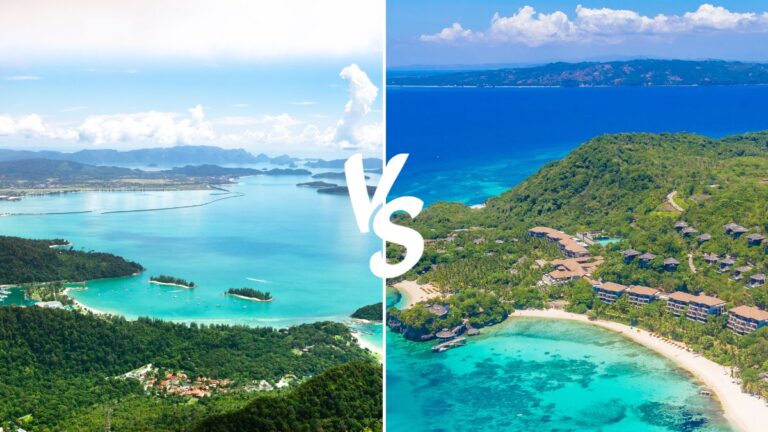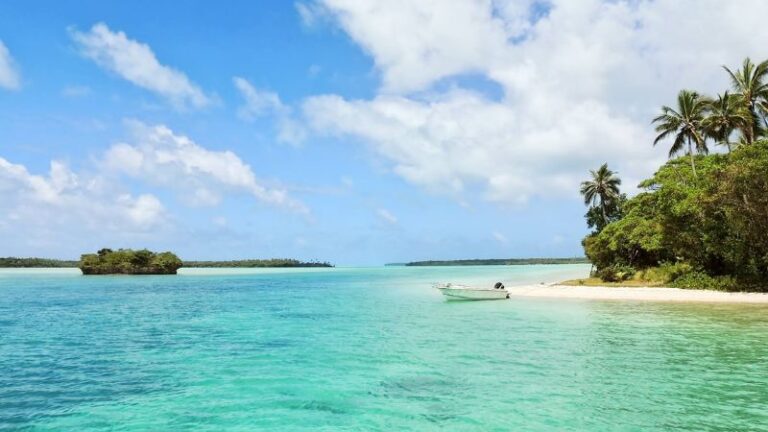Azores vs. Canary Islands: Atlantic Archipelagos with Volcanic Landscapes
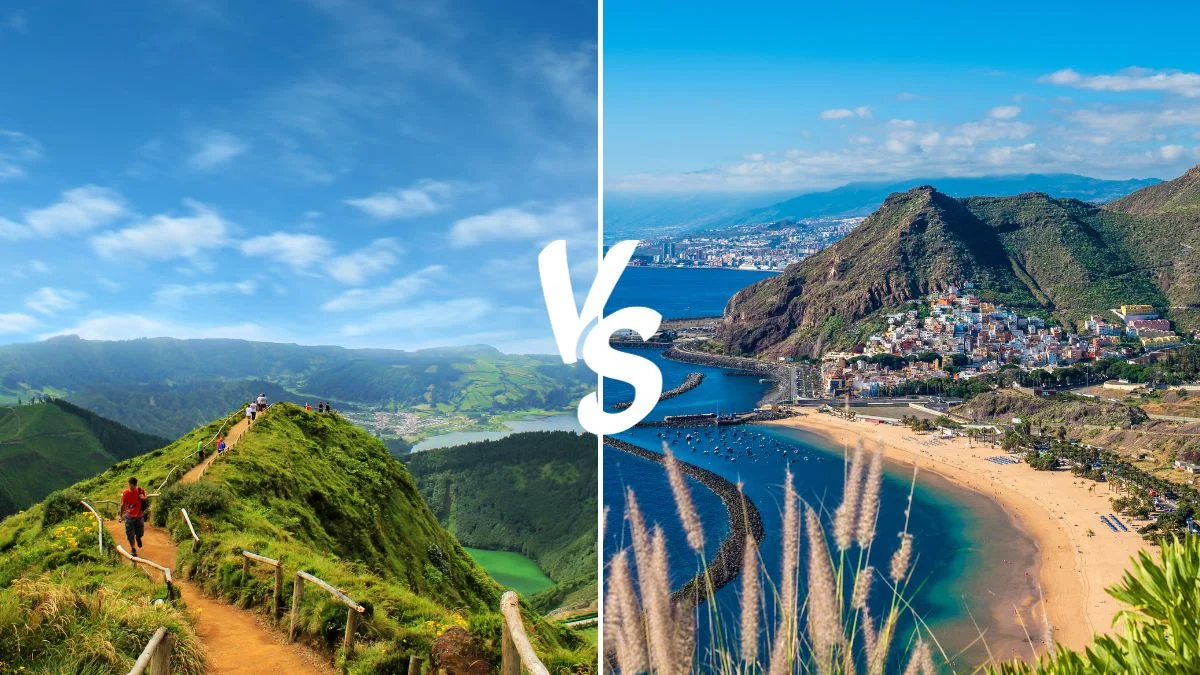
As participants in Amazon Associates and other programs, we earn from qualifying purchases. This comes at no additional cost to you. For more details, see our Affiliate Disclosure.
Nestled in the vast expanse of the Atlantic Ocean, the Azores and the Canary Islands stand as testament to the earth’s fiery underbelly. Both archipelagos, shaped by volcanic activity, offer a mesmerizing blend of natural beauty, rich culture, and unique geographies. Whether you’re a traveler looking to explore untouched terrains or simply curious about these island jewels, diving into a comparison of the Azores and the Canary Islands reveals a world of wonders awaiting discovery.
HIGHLIGHTS
- The Azores offer tranquility and geothermal wonders, while the Canary Islands present diverse landscapes and activities.
- Culinary contrasts exist, Azores with its unique Cozido das Furnas and the Canary Islands with a blend of cultural flavors.
- The Canary Islands boast better accessibility and connectivity; the Azores provide a secluded experience.
- Choice between the two is based on personal preferences: Azores for quietude, Canaries for variety.
Geological Beginnings: The Volcanic Birth of the Islands
The formation of the Azores and the Canary Islands is a tale as old as time, rooted deeply in the geological dynamism of our planet. Both archipelagos have been shaped and carved by the ceaseless energy of volcanic eruptions, a process that has given them their distinctive landscapes and features. But while their origins are volcanic, their individual journeys through time and the events that have sculpted them vary, offering unique stories of evolution and change.
Azores
The Azores, located at the triple junction of the North American, Eurasian, and African tectonic plates, have a unique geological setting that has contributed to their formation. This strategic position meant that the archipelago has been formed by the upwelling of magma from the mantle, resulting in the emergence of these islands from the ocean floor.
Over the millennia, repeated eruptions and seismic activity have sculpted the landscapes of the Azores, leading to their lush terrains interspersed with calderas, fumaroles, and hot springs. The islands’ relatively young age, geologically speaking, means that they continue to evolve, with occasional tremors and volcanic activities serving as reminders of their fiery origin.
Canary Islands
In contrast, the Canary Islands owe their existence to a hotspot—a plume of molten rock rising from the Earth’s mantle, creating pressure that forces magma to the surface. This hotspot has been responsible for the archipelago’s birth over the past 20 million years, with each island forming at different times.
As a result, the eastern islands like Lanzarote and Fuerteventura are older with more eroded landscapes, while the western ones like La Palma and El Hierro are younger with more recent volcanic activities. This gradient of age across the archipelago has resulted in diverse landscapes, from stark lava fields to verdant laurel forests, each telling a different chapter of the islands’ geological saga.
While both the Azores and the Canary Islands owe their existence to volcanic activities, their individual formations are distinct. The Azores, birthed at a tectonic crossroads, showcase landscapes still in the throes of geological youth, ever-evolving and dynamic. The Canary Islands, on the other hand, present a tapestry of ages and stages, from ancient eroded terrains to fresh volcanic landscapes. The Canary Islands, with their gradient of age and the tales each island holds, might just have a slight edge in this category.
Natural Beauty: Comparing the Landscapes and Sceneries
The allure of islands often lies in their untouched beauty, a combination of nature’s best elements, all converging in a small parcel of land. The Azores and the Canary Islands, although both sculpted by volcanic forces, present different versions of nature’s canvas. While both offer breathtaking vistas, their individual landscapes and sceneries are as diverse as their geological histories. The play of light on waterfalls, the expanse of endemic flora, and the rugged charm of lava terrains—all contribute to the visual narratives of these islands.
Azores
The Azores are often likened to a garden in the middle of the Atlantic. With their emerald green pastures, dense forests, and shimmering blue lakes nestled in volcanic craters, they offer a serene and lush panorama. The islands boast dramatic cliffside views, like those at Santa Iria on São Miguel or Capelinhos on Faial, where the mighty Atlantic crashes against the shore.
The Azores also present a tapestry of colors with their hydrangea-bordered roads, blue and green twin lakes of Sete Cidades, and the stunning views from Mount Pico, Portugal’s highest mountain. The tranquility and untouched beauty of the archipelago make it a haven for nature lovers.
Canary Islands
The Canary Islands, by contrast, are a more diverse set in terms of landscapes. From the golden dunes of Gran Canaria to the moon-like terrains of Lanzarote’s Timanfaya National Park, there’s a stark yet beautiful contrast at every turn. Tenerife, home to Spain’s highest peak, Mount Teide, offers a blend of tropical beaches and alpine scenery.
The ancient laurel forests of La Gomera and Garajonay National Park provide a mystical and ancient aura, while the black sand beaches of La Palma and El Hierro exude an otherworldly charm. The Canaries, with their mix of desert landscapes, volcanic craters, dense forests, and pristine beaches, offer a visual treat for every kind of traveler.
Both the Azores and the Canary Islands possess natural beauty that captivates and enchants visitors. The Azores, with their lush, garden-like landscapes, provide a sense of peace and seclusion. Meanwhile, the Canary Islands present a multifaceted beauty, from deserts to forests, each island showcasing its own unique charm. In terms of sheer diversity of landscapes and sceneries, the Canary Islands take the crown, but for those seeking an undisturbed, verdant paradise, the Azores might hold a special place in their hearts.
Culture and Heritage: A Glimpse into Island Life and Traditions
Islands, often isolated from mainland influences, develop unique cultures and traditions that become the essence of their identity. The Azores and the Canary Islands, though both situated in the vast Atlantic, offer distinct cultural experiences influenced by their history, geography, and external interactions. Delving into their traditions, festivals, and way of life provides an intriguing glimpse into the heart and soul of these archipelagos.
Azores
The Azores, a Portuguese archipelago, exude a culture deeply rooted in seafaring and agriculture. Their isolation led to a development of unique traditions, many of which are celebrated with vibrant festivals. The “Festas do Espírito Santo” is one such event, a series of religious celebrations invoking the Holy Spirit, marked with processions, music, and shared meals.
The islands’ cuisine is a testament to their volcanic nature—dishes like “Cozido das Furnas,” where food is slow-cooked using geothermal heat, showcase a blend of tradition and nature. Additionally, the Azorean heritage is rich in crafts, particularly in lace-making and pottery, and their folklore is filled with tales of sea monsters and brave sailors, reflecting their bond with the ocean.
Canary Islands
The Canaries, although Spanish, have a cultural tapestry influenced by aboriginal Guanches, who were the islands’ first known inhabitants. This Berber-related indigenous heritage is still evident in traditions like the “Silbo Gomero”—a whistled language used in La Gomera. Festivals, such as “Carnaval,” are grand affairs in the Canaries, rivaling the famous Rio Carnival in their fervor and color.
The islands’ music and dance, like the “Isa” and “Folías,” bear traces of African, Latin American, and Spanish influences. Gastronomically, the Canaries offer delights such as “papas arrugadas” (wrinkled potatoes) with “mojo” sauce and “gofio,” a versatile flour with ancient origins. The blend of indigenous and external influences has crafted a culture in the Canaries that is both distinctive and diverse.
While both the Azores and the Canary Islands offer rich cultural experiences, they are markedly distinct in their heritage and expressions. The Azores provide a more homogeneous experience, deeply rooted in Portuguese traditions and their maritime legacy. In contrast, the Canary Islands offer a melting pot of influences, from indigenous to African and Spanish. If one were to choose a winner based on the depth and diversity of culture, the Canary Islands would edge ahead, with their multifaceted heritage painting a more intricate tapestry of traditions.
Biodiversity: Unique Flora and Fauna of Each Archipelago
Island ecosystems, often isolated from larger landmasses, become fascinating hubs of biodiversity. Over millennia, species adapt and evolve in response to the unique challenges and opportunities presented by island life. The Azores and the Canary Islands, both born from the same volcanic origins in the Atlantic, have cultivated their own distinctive ecosystems teeming with life. From endemic species to captivating natural habitats, these archipelagos are living museums of evolutionary wonder.
Azores
The Azorean archipelago is a haven for marine life, thanks to its location in the middle of the North Atlantic. Numerous species of whales and dolphins, like the sperm whale and the common dolphin, frequent its waters, making it one of the world’s premier locations for cetacean watching.
On land, the Azores is home to a number of bird species, some of which are endemic like the Azores bullfinch. The islands also possess lush laurel forests, remnants of ancient woodlands that once covered southern Europe. These forests host a variety of flora, such as the Azorean heather and juniper, which have adapted to the archipelago’s unique conditions.
Canary Islands
The Canary Islands, owing to their larger size and diverse landscapes, boast an even wider spectrum of biodiversity. Their uniqueness lies in the presence of species that have survived since the Tertiary period, making the islands a living fossil showcase. The “laurisilva” or laurel forests of the Canaries are UNESCO World Heritage sites and house species like the Canarian pine and the dragon tree.
The islands are also a birdwatcher’s paradise, with species like the blue chaffinch and the Canary Islands stonechat calling them home. Additionally, the Canaries possess a plethora of reptiles and insects, many of which, like the Canary Islands giant lizard, are found nowhere else on Earth.
Both the Azores and the Canary Islands are treasuries of biodiversity, offering unique species shaped by island evolution. The Azores stand out for their marine biodiversity, especially the captivating cetaceans that roam their waters. The Canary Islands, on the other hand, present a broader range of habitats and species, especially their ancient “laurisilva” forests and diverse terrestrial fauna. In the contest of biodiversity, while the Azores are undoubtedly rich, the Canary Islands, with their vast array of habitats and endemic species, claim the spotlight in this category.
Adventure Activities: Exploring the Rugged Terrains and Blue Seas
Adventure beckons at every corner of the world’s most captivating islands. For thrill-seekers and nature enthusiasts, the rugged terrains and vast blue seas of the Azores and the Canary Islands offer a myriad of activities that not only challenge the body but also invigorate the soul. From diving into the deep to scaling towering peaks, both archipelagos are playgrounds of natural wonders, waiting to be explored.
Azores
In the Azores, the intertwining of land and sea offers diverse adventure options. The islands are a hotspot for whale and dolphin watching, with the chance to witness these majestic creatures in their natural habitat. Diving enthusiasts can explore underwater volcanic formations, old shipwrecks, and vibrant marine life.
On land, the islands boast numerous hiking trails, such as the ones in Flores, which meander through waterfalls and lakes. The volcanic nature of the Azores also means there are unique experiences on offer, like bathing in natural thermal pools in São Miguel or exploring the underground lava tubes in Terceira. For those seeking aerial views, paragliding over the green landscapes offers an exhilarating perspective.
Canary Islands
The Canary Islands, with their diverse landscapes, provide an adventure for every taste. Tenerife’s Mount Teide, Spain’s highest peak, lures trekkers and climbers with its lunar-like terrains and panoramic vistas. For water enthusiasts, the blue waves offer opportunities for windsurfing, especially in Fuerteventura, often dubbed the “Hawaii of Europe.”
The deep waters off the coast of the Canaries are also a diver’s paradise, with underwater caves, diverse marine species, and even a submerged sculpture museum in Lanzarote. For adrenaline junkies, there are dune-bashing experiences in Gran Canaria’s Maspalomas dunes or parascending over the islands’ coasts, giving a bird’s-eye view of their beauty.
Both the Azores and the Canary Islands cater to the heartbeats of adventure lovers. While the Azores offer a harmonious blend of marine and volcanic experiences, the Canaries bring forth a broader palette of adventures owing to their varied landscapes. If the choice boils down to the range of activities, the Canary Islands might hold a slight advantage with their diverse offerings across different terrains. However, for a more intimate and unique volcanic experience, the Azores stand out as a mesmerizing destination.
Climate and Weather: What to Expect When You Visit
Climate plays a pivotal role in shaping travel experiences. From planning the perfect beach day to ensuring a successful hike, understanding the weather of a destination can be the key to a memorable trip. The Azores and the Canary Islands, although both situated in the Atlantic, offer varied climates influenced by their geographical locations, altitudes, and oceanic currents. Let’s delve into the climatic nuances of these two archipelagos to provide travelers with a clear picture of what to anticipate.
Azores
The Azores enjoy a temperate maritime climate, characterized by mild temperatures throughout the year. Summers, from June to September, witness temperatures ranging from 20°C to 26°C (68°F to 79°F), making it pleasant for outdoor activities. Winters are cooler, with temperatures hovering between 13°C to 17°C (55°F to 63°F).
Due to their location in the middle of the Atlantic, the islands experience relatively high humidity and frequent, albeit short-lived, rain showers, leading to their lush landscapes. The Azorean weather can be unpredictable, and it’s not uncommon to experience all four seasons in a single day, a phenomenon locals often refer to as “four seasons in one day.”
Canary Islands
Often termed the “Islands of Eternal Spring,” the Canary Islands benefit from a subtropical climate. Their proximity to the African continent and the influence of the Canary Current ensure warm temperatures year-round. Summers are dry and warm with average temperatures between 22°C to 28°C (72°F to 82°F), while winters remain mild, rarely dropping below 15°C (59°F).
The variation in altitude across the islands also introduces microclimates. For instance, the mountainous regions in Tenerife or Gran Canaria can be cooler and receive more rainfall compared to the coastal areas. The eastern islands, like Lanzarote and Fuerteventura, tend to be drier due to the Saharan influence, while the western islands receive more precipitation, supporting lush laurel forests.
When it comes to climate, both archipelagos offer comfortable temperatures that cater to year-round travel. The Azores, with their unpredictable and ever-changing weather patterns, are perfect for those who enjoy the mystery of nature and don’t mind occasional showers. The Canary Islands, with their stable and warm climate, are ideal for sun-seekers and those looking for consistent weather patterns. If consistency and warmth are primary criteria, the Canary Islands take the lead. However, for a more dynamic and ever-changing weather experience, the Azores provide an intriguing option.
Culinary Delights: A Taste of Island Cuisine
Cuisine, an embodiment of culture and history, is often a central aspect of travel experiences. The thrill of tasting unfamiliar dishes, prepared with love and tradition, can transport one to the very heart of a destination. The Azores and the Canary Islands, despite their shared Atlantic setting, bring to the table a palette of flavors distinct in character and essence. From the fruits of the sea to the produce of the land, let’s embark on a culinary journey through these island paradises.
Azores
Azorean cuisine is a testament to the islands’ rich maritime heritage and fertile volcanic soils. Seafood naturally takes center stage, with dishes like “Caldeirada” (a fish stew) or “Lapas grelhadas” (grilled limpets) showcasing the ocean’s bounty. But it’s perhaps the “Cozido das Furnas” that stands out—a meat and vegetable stew slow-cooked in the geothermal heat of São Miguel’s volcanic grounds.
The archipelago also offers an array of dairy products, with São Jorge Island’s tangy cheese being particularly renowned. For those with a sweet tooth, “Queijadas da Vila,” small custard-like pastries, are a must-try. To wash it all down, the locally produced wines and the unique “Chá Gorreana” — Europe’s only tea plantation product — make for delightful beverages.
Canary Islands
Canarian cuisine, a fusion of Spanish, African, and Latin American influences, offers a plethora of flavors. One of its most iconic dishes is “Papas arrugadas” — wrinkled potatoes boiled in sea salt and typically served with “mojo” sauces, which can range from spicy to garlicky. The islands also boast an array of fresh seafood dishes, such as “Vieja” (parrotfish) and “Caldo de pescado” (fish soup).
Meat lovers can indulge in “Conejo en salmorejo” (rabbit in a rich marinade) or “Carne de cabra” (goat meat). The sweetness of the Canaries comes in the form of desserts like “Bienmesabe,” a rich almond cream, and “Quesillo,” a silky flan. The islands’ wines, especially those from La Geria region in Lanzarote, are well-regarded and offer a perfect accompaniment to meals.
Both the Azores and the Canary Islands present a rich tapestry of flavors, rooted in their history and geography. The Azores, with their geothermal wonders and maritime traditions, offer dishes that are both hearty and unique. On the other hand, the Canary Islands, with their blend of cultural influences, serve a more diverse range of culinary delights. If the quest is for a wide variety of tastes influenced by multiple cultures, the Canary Islands have an edge. However, for those seeking a deeply authentic and geographically unique dining experience, the Azores hold a special charm.
Getting There: Travel Tips and Accessibility
Accessibility is often a critical factor for travelers when choosing a destination. While the allure of pristine beaches, volcanic landscapes, and unique cultures is enticing, reaching such places seamlessly becomes an essential consideration. Both the Azores and the Canary Islands, nestled in the vastness of the Atlantic, offer distinct travel experiences. Let’s evaluate the ease of getting to these paradisiacal archipelagos, along with some handy travel tips.
Azores
Situated roughly halfway between North America and mainland Europe, the Azores are serviced primarily by the Azores Airlines (previously SATA) and TAP Air Portugal. Direct flights to the main island, São Miguel, are available from various European cities, as well as a few North American ones like Boston and Toronto.
Once in São Miguel, inter-island flights or ferries can be taken to explore the other islands. It’s advisable to book flights in advance, especially during the summer peak season.
Travel tip: If your itinerary permits, consider the Azores Airlines’ stopover program, which allows travelers to stay in the Azores for up to 7 days en route to another destination without additional airfare.
Canary Islands
The Canary Islands, being a popular European holiday destination, boast excellent air connectivity. Numerous airlines, including budget carriers, operate regular flights from major European cities to the islands’ several airports, with Tenerife, Gran Canaria, and Lanzarote being the primary hubs. Additionally, there are inter-island flights and ferries, making island-hopping convenient.
For travelers from the Americas or Asia, it’s often easiest to fly into a major Spanish city like Madrid or Barcelona and then take a domestic flight to the Canaries.
Travel tip: Considering the popularity of the Canaries, especially during European winter months, it’s wise to scout for deals and book tickets early to secure favorable prices.
In terms of accessibility, the Canary Islands, given their established reputation as a major tourist destination, offer more extensive connectivity and a broader range of flight options. The Azores, while not as extensively connected, provide a more off-the-beaten-path experience and have the added advantage of the stopover program for transatlantic travelers. If ease and variety of flight options are the primary criteria, the Canary Islands come out on top. However, for those seeking a slightly more secluded and unique journey, the Azores offer an enchanting gateway.
Azores vs. Canary Islands: Which Archipelago Calls to You?
The Azores and the Canary Islands stand as jewels of the Atlantic, each with its distinct allure. The Azores, a cluster of nine volcanic islands, offer a blend of lush landscapes, geothermal wonders, and a serene ambiance that resonates with those seeking tranquility and unique experiences. The Cozido das Furnas, a stew cooked with Earth’s natural heat, epitomizes the archipelago’s culinary originality. In terms of accessibility, the Azores are more secluded, ideal for travelers searching for an off-the-beaten-path adventure.
Contrastingly, the Canary Islands offer a tapestry of experiences, from the sandy dunes of Gran Canaria to the volcanic terrains of Lanzarote. The islands’ culinary scene is a melange of Spanish, African, and Latin American flavors, with Papas arrugadas being a must-try. Given their reputation as a prime European vacation spot, they boast better connectivity and a wider range of activities, catering to both adrenaline junkies and relaxation seekers.
In conclusion, choosing between the Azores and the Canary Islands boils down to personal preference. If a quieter, geographically unique experience resonates with you, the Azores beckon. However, for diverse landscapes and a broader palette of activities, the Canary Islands are hard to resist. Both archipelagos, with their own charms, await the discerning traveler.

